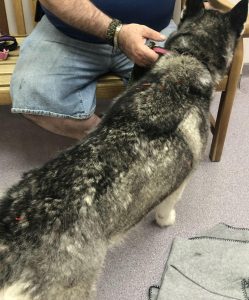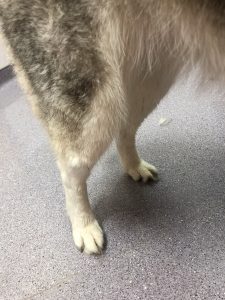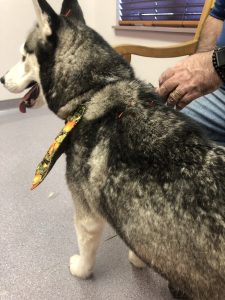Written by a CuraCore Veterinary Medical Acupuncture course graduate. Signed release obtained from client/author. 4S2019023
ABSTRACT
Behavioral problems are a leading cause for canine relinquishment to shelters. The generalized approach to management includes environmental modifications and pharmaceutical intervention. The patient in this case report, Enya, presented for escalating resource guarding behavior. Avoidance, redirection, and Zylkene administration were instituted as a initial treatment approach. It was not, however, until Enya received once weekly acupuncture, laser, and massage that the frequency and severity of this behavior started to decline.
HISTORY AND PRESENTATION
Enya is a 6 year old female spayed Siberian Husky who presented for baring of her teeth, growling, and lunging when the owner’s would enter the laundry room, where the patient’s bed is located. To diffuse the situation, the owner’s would back away slowly and leave the room.
The owners were instructed to practice avoidance tactics and to redirect the aggression with a favorable object, activity, or treat. Enya was also prescribed Zylkene (450mg, 1 capsule every 24 hours), a hydrolyzed milk protein with reported calming properties. Environmental modification involved installation of a Dog Appeasing Pheromone diffuser, playing of classical music, and relocation of Enya’s bed into a different area of the house. After 4 weeks of this therapy with actual worsening response, the owners were given the option to pursue more advanced pharmacologic intervention /or acupuncture, laser therapy, and massage. The owner’s elected to try the alternative modalities before adding in another pharmacologic agent.
Enya has little past medical history with this owner. She was adopted at 6 months of age from an abusive and neglectful situation. She lived in a dorm room, was fed scraps of human food when available (no kibble), and was physically abused by the male owner. Enya now lives with two adults (male and female), as well as two other dogs who she doesn’t interact with.
PHYSICAL EXAMINATION AND CLINICAL ASSESSMENTS
General exam- Bright, alert responsive. Body Condition Score 5/9. Muscle condition score 4/4. No lameness appreciated at the walk or trot. Full range of motion (ROM) of the forelimbs, hind-limbs, and cervical region, without any crepitus or pain noted. No asymmetry appreciated in any of the joints. Remainder of physical exam was within normal limits.
Myofascial Exam- Mild tight banding found in the trapezius, latissimus dorsi, cleidocephalicus pars cervicalis and brachiocephalic muscles.
Neurologic Exam- Intact menace/pupillary light response/palpebral/nasal sensation. No conscience proprioception deficit noted. Intact patellar reflex. Crossed extensor was not evaluated. Adequant jaw and anal tone.
Behavioral Exam-
At the initial acupuncture consultation, the patient exhibited many signs of stress and fear (see below). When approached, she would either back away or roll onto her back and present her ventrum. She is very food motivated and willing took treats from the floor and hand.
Signs of stress: mild-moderate including lip licking, yawning, panting, closed mouth, pupil dilation, whining, pacing, tail wagging, ear pinning/pricking, and shaking off/stretching.
Signs of fear: mild-moderate including lowered head, lowered tail, stiffening/stilling, averting head/gaze, avoidance/hiding, and abruptly turning.
PROBLEM LIST
Growling/lunging in the laundry room (moderate-severe)
Fearful behavior during exam (mild)
Myofascial restrictions in the cervical/brachial musculature (mild)
DIFFERENTIAL DIAGNOSES
Resource guarding and aggression Brachial/cervical myofascial restriction
Vascular- hypertension Vascular- Fibrocartilagenous Embolism
Inflammatory/Infection- rabies Inflammatory/Infection- polymyositis
Neoplastic- intracranial neoplasia (glioblastoma) Neoplastic- Rhabdomyosarcoma
Degenerative- extradural synovial cyst Degenerative- intervertebral disc disease
Iatrogenic- positive punishment, negative reinforcement Iatrogenic- sympathetic arousal from triggers
Congenital- Lissencepahly Congenital- Myasthenia Gravis
Autoimmune- granulomatous meningoencephalitis Autoimmune- Systemic lupus erythematosus
Traumatic- triggers during fear period of puppyhood Traumatic- infraspinatus contracture
Endocrine- hyperthyroidism Endocrine- Hypoadrenocorticism
DEFINITIVE DIAGNOSES
The iatrogenic and traumatic causes are likely the root to Enya’s current behavioral problems. Her complete blood count, chemistry, and blood pressure were within normal limits and she has no other clinical signs to suggest a medical etiology motivating her aggression. There is also substantial evidence from the current owners that her previous owners abused and starved her leading to the behavioral fall-out exhibited today. I believe her cervical tension is secondary to her sympathetic windup from being in a frequent state of agitation since her musculoskeletal exam was within normal limits.
MEDICAL DECISION MAKING
My goal for Enya’s treatment was to neuromodulate the autonomic nervous system (ANS) in order to drive down her heightened sympathetic tone. My secondary goal was to provide pain relief for the cervical and brachial muscles. I did this with a combination of needling, laser therapy, and massage for a total of 6 sessions. She is now currently receiving the same treatment regimen at a “lowest effective dose” of a 14 day interval. My tertiary goal was to perform these therapies while maintaining the safety of all participants. Along those lines, Enya was offered food throughout the entire process and if any sign of irritation was displayed when the intended point was palpated, it was not pursued.



MEDICAL ACUPUNCTURE AND RELATED TECHNIQUES USED
My first three treatments were trust building so the number of dry-needling points were minimized and purposively targeted to areas along the dorsum and large muscle bellies in order to avoid any nociceptive stimulation. Red SEIRIN J-Type (0.16x30mm) needles were purposively selected for their small size and also for their ease in finding the needles through her thick arctic coat. When peripheral points were introduced, Korean hand needles (0.18x8mm) were employed due to their ease of insertion, small length, and relative small diameter.
My initial sessions involved dry needling GV 20, Bai Hui, GB 20, BL 10, GV 14, and BL11-14. I chose GV 20, Bai Hui, and GV 14 for their central and autonomic neuromodulation properties as follows: GV 20 is the site where C2-C3 and trigeminal pathways meet with parasympathetic neuromodulation via cross talk with the vagus nerve; Bai Hui is at the site of the lumbosacral plexus with neuromodulation via nervi vasorum; and GV 14 is at the site where sympathetic fibers leave T1 with neuromodulation via central mechanisms.
I chose BL 10, GB 20, and BL11-15 for their local effects on the musculature as follows: BL 10 is at the site of C1-C2 spinal nerves which supply some of the muscles that were strained (such as cleidocephalicus); GB 20 is between the attachments of the sterno-occipitalis and cleidocervicalis (muscles that were directly strained); BL11-14 are at the site of the T1-T4 thoracic vertebra respectively, which supply some of the muscles that were strained. The sympathetic chain ganglia are also in this region so these points had added neuromodulation impact. After building Enya’s trust, I was able to include some more distal points including ST 36 and HT 7 for their parasympathetic stimulation.
Depending on the session, I also directly needled trigger points which were localized to the shoulder and cervical region. During the initial sessions, I used red SEIRIN’s to break down these tension points but as we both gained trust in each other, I selected Carbo CB1 (0.20 x 25mm) in order to achieve a more robust response. I considered adding in auricular points, since in human literature they show promise for anxiety management, however, since our current approach has showed positive results, I have not instituted more changes.
In each session, Enya’s whole body was massaged before and after dry-needling using mostly petrissage and effleurage techniques. My goal was to release tension and provide a calming touch, so some of the more stimulating techniques such as tapotement and friction were avoided. I specifically massaged the lumbar and hip region (even though there were no tight bands found in these regions), so that Enya would get accustomed to my touch in these areas in order for her to accept needling in these regions more readily.
Photobiomodulation was also provided in every session in order to directly relieve the sore muscles in the neck/shoulder region as well as to stimulate distant acupuncture points that could not be dry-needled due to patient temperament. The type of laser used was a Summus Platinum 4 class IV laser which has four available wavelengths (650 nm, 810 nm, 915 nm, and 980nm) with a max power of 28 watts. The cervical and brachial region was lasered with a continuous wave (915Hz, 1185J for 2 minutes and 30 seconds.) The forelimb was lasered specifically at points HT 7 and PC 6 both for parasympathetic reinforcement. The hindlimb was lasered at points ST 36 for a similar rationale as the forelimb. A pulsed wave was used for these treatments using 500 hz, 12 J for 24 seconds.
DISCUSSION
Acupuncture has been shown in the literature to be a promising tool for anxiety management. Kim et al. showed that acupuncture (specifically at GV 20 and Yin Tang) produces a more profound sedation when used in conjunction with pharmaceuticals, as opposed to those sedated with pharmaceuticals alone. 1 This shows acupuncture may help reduce agitation by decreasing sympathetic tone and therefore allowing the dogs in the study to achieve a greater plane of relaxation. Another study in chronic mild stressed (CMS) rats, showed stimulation of PC6 decreased their anxiety when compared to a sham point .2 Photobiomodulation also has evidence supporting it’s indication for anxiety disorders. For example, Saltmarche et al. used 810 nm, 10 Hz pulsed light-emitting diode devices on human dementia patients and found “increased function, better sleep, fewer angry outbursts, less anxiety, and wandering.” 3 Eshaghi et. al. provides some mechanism for laser therapy management of anxiety in mice via increasing 5-HT and decreasing NO levels in the prefrontal cortex and hippocampus.4 Massage therapy is almost synonymous with relaxation but studies have supported it’s anti-anxiety effects. Diego et. al. found in their study that if moderate vs light pressure massage was employed, the parasympathetic nervous system was stimulated.5 In Enya’s case, we hypothesized that her increased sympathetic tone was an underlying trigger behind her resource guarding outbursts, thus stimulation of this arm of the ANS was adventitious to our desired goal of a more relaxed pup. Another study by Pinar et. al found dorsal massage reduced anxiety via reduction of cortisol levels, blood pressure, and pulse rate.6
Eyna’s response to her acupuncture, laser, and massage treatments was profound. After her first session, the frequency of her “outbursts” dropped from 3-5 events per week to 1-2 events per week. After 3+ sessions, the frequency dropped to 1 event around every other week. The intensity of the displayed behavior was also significantly altered after just one acupuncture session. Instead of barking and lunging, Eyna’s resource guarding now involves a low deep growl which can be successfully redirected with an object, treat, or task. Enya’s demeanor in the exam room has also changed. She now always greets me when I enter the room and instead of displaying 5+ signs of stress and fear, Enya’s signs of uncomfortability are minimal. These signs are now limited to panting (which in Enya’s case could simply be thermoregulation as these sessions were taking place during summer), rolling on her back, and pacing.
In addition to improving her resource guarding, some of Enya’s other “quirks” were inadvertently positively impacted. Enya now lets her owners put her harness on without the prior struggle involving running away and vocalizing. She also readily settles during car rides instead of panting and pacing for the duration of the trip. These positive behavioral changes were most likely due to these alternative therapies since the prior treatment modalities had no effect and no other pharmaceuticals or environmental modifications were introduced. This assumption could be further validated if we performed a challenge by discontinuing the Zylkene, however this has not been pursued at this time. Knock on wood, we have experienced minimal adverse events during Enya’s treatments. There was one session where the owner reported finding a Korean hand needle in the car, showing that not all of the needles were accounted for. This risk has been mitigated by counting the needles inserted and assuring all have been retrieved prior to discharge.
In summary, this case report has illustrated that acupuncture, laser, and massage should be more readily offered for the management of mild-moderate anxiety and fear in dogs. I am eager to develop more of a case load in this area with the knowledge that patient selection must be taken very seriously in order to avoid any injuries. The overall risks of these modalities for the patients are minimal though and in certain cases can be more safe than use of selective serontinin reuptake inhibitor (i.e. risk of serotonin sickness syndrome, renal/hepatic accumulation, stress of pilling). This report also shows that more studies need to be performed using companion animal models to further validate the MAIN approach for anxiety management.
REFERENCES
1. “Electroencephalographic Spectral Edge Frequency 95 in Dogs Sedated by Acupuncture at GV20 or Yintang and Sedative Combination.” Kim, Min-Su1; Soh, Kwang-Sup2; Nam, Tchi-Chou3; Seo, Kang-Moon3; Litscher, Gerhard. Acupuncture & Electro-Therapeutics Research, Volume 31, Numbers 3-4, 2006, pp. 201-212(12)
2. “The effects of acupuncture stimulation at PC6 (Neiguan) on chronic mild stress-induced biochemical and behavioral responses.” Kim H1, Park HJ, Han SM, Hahm DH, Lee HJ, Kim KS, Shim I. Neurosci Lett. 2009 Aug 21;460(1):56-60. doi: 10.1016/j.neulet.2009.05.008. Epub 2009 May 7.
3. “Significant Improvement in Cognition in Mild to Moderately Severe Dementia Cases Treated with Transcranial Plus Intranasal Photobiomodulation: Case Series Report.” Anita E Saltmarche 1, Margaret A Naeser 2, Kai Fai Ho 3, Michael R Hamblin 4, Lew Lim. Photomed Laser Surg. August 2017;35(8):432-441.
4. ”Transcranial photobiomodulation prevents anxiety and depression via changing serotonin and nitric oxide levels in brain of depression model mice: A study of three different doses of 810 nm laser.” Eshaghi E1,2, Sadigh-Eteghad S1, Mohaddes G1, Rasta SH. Lasers Surg Med. 2019 Sep;51(7):634-642. doi: 10.1002/lsm.23082. Epub 2019 Mar 18.
5. “Moderate pressure massage elicits a parasympathetic nervous system response.” Diego MA and Field T. International Journal of Neuroscience. 2009;119:630-638.
6. “Back Massage to Decrease State Anxiety, Cortisol Level, Blood Pressure, Heart Rate and Increase Sleep Quality in Family Caregivers of Patients with Cancer: A Randomised Controlled Trial.” Rukiye Pinar 1, Fisun Afsar. Asian Pac J Cancer Prev. January 2015;16(18):8127-33.